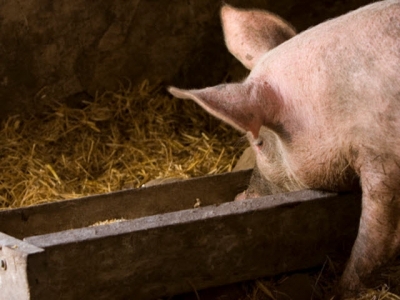Researchers question efficacy of low-protein, high-fiber diets on pig development

Diets with low protein or high fiber levels fail to improve growth or weight gain in growing-finishing pigs and may require more amino acid (AA) work, say researchers from the University of Lleida-Agrotecnio Center in Spain.
The low protein diet resulted in increased back-fat thickness, decreased carcass price and reduced growth for older pigs, according to findings published in Animal Feed Science and Technology. The findings suggest that it may be more accurate to design diets based on dietary lysine levels and lysine to energy ratios rather than dietary crude protein (CP) levels, said the researchers.
“Taken into account that energy intake is limiting the protein deposition during the early phase of growth, the SID (standardized ileal digestible) lysine to ME (metabolizable energy) ratio should be increased when dietary CP is reduced,” they wrote.
Study details
The researchers sought to determine the effects of decreasing crude protein , and boosted neutral detergent fiber (aNDFom) on the growth performance, nutrient digestibility, manure composition and carcass features of finishing pigs by testing diet combinations including high protein and high fiber, high protein and low fiber, low protein and high fiber and low protein and low fiber diets.
In the experiment, 64 male pigs were assigned to one of two CP levels and one of two aNDFom levels in a 2x2 factorial design for a period of 15 weeks, said the scientists. The time was broken into three phases – 6-11 weeks of age, 12-16 weeks and 17-21 weeks.
The diets were comprised predominantly of barley, soybean meal, sorghum, wheat and offered similar ME, lysine content and ideal amino acids, they said. The high fiber diets also included rapeseed meal and sugar beet pulp. The diets were altered as the pigs aged and chromic oxide was used as an indigestible marker to determine apparent whole-tract digestibility.
Throughout the experiment, body weight and the amount of feed eaten were recorded for each pen to calculate average daily gain and average daily feed intake (ADFI), they said. Additionally, back-fat thickness (BFT) was measured at the conclusion of each phase. And, fecal samples were analyzed for dry matter (DM), ash and nitrogen content
Results
Researchers found that the CP and the aNDFom did not act in concert and resulted in separate effects on ADFI, BW and growth efficiency, they said.
Throughout the phases, the amount of CP didn’t change ADFI, but it did have an effect on BW, the scientists said. Pigs on the high protein diet grew more rapidly from 12-21 weeks and had an improved gain:feed ratio and more efficient energy use.
The protein level didn’t alter the amounts of either DM or some nutrients digested at week 11, though by week 21 digestion of DM, some nutrients and carbohydrates (CHO) was higher for pigs getting less protein, they said. Additionally, CHO digestion was higher at week 11 for pigs on the low protein diet. There were no alterations to the amount of AEE digested.
The high fiber diet had mixed results for digestion as it limited the amounts of DM, some nutrients and CHO that were digested at week 21, but it improved the digestion of AEE at weeks 16 and 21, said researchers.
Economic details
Researchers also examined the costs associated with the different diets and pig production. These included the price of feed and ADFI for the different growing and finishing phases, they said. Carcass price was determined by weight and standard EU classification. The economic gross margin was calculated by subtracting diet costs from the carcass income.
In the study, researchers found that a low CP and high ANDFom diet was less expensive than a diet that had both high CP and high aNDFom, but the other two diets didn’t have an effect on diet cost, they said. Diets with low protein levels or high fiber produced the most BFT at 13.51 mm for the high protein diet and 16.06 mm for low protein, and 14.09mm for low fiber and 15.47mm for higher fiber. However, the low protein diets resulted in a reduced carcass income and economic margin, in relation to pigs getting a high protein diet. Fiber content did not change the carcass income or economic margin.
Manure changes
By week 21 pigs on the low protein diet made more manure, though there were no differences at week 11, and there was more DM in the feces for pigs on the high protein diet, said scientists. Pigs on the high fiber diet produced more manure at both weeks 16 and 21. There also was a higher DM content for pigs on the high fiber diet, though it decreased as the pigs aged.
The density and electrical conductivity were higher at 21 weeks for pigs eating a diet high in protein and fiber, they said. The high protein diet also produced waste with higher pH values.
“Although low CP diets can reduce nitrogen emissions and improve intramuscular fat content and sensory quality simultaneously, the economic margins that result under current market conditions make this dietary manipulation an infeasible nutritional strategy,” said the researchers.
Có thể bạn quan tâm
Phần mềm

Phối trộn thức ăn chăn nuôi

Pha dung dịch thủy canh

Định mức cho tôm ăn

Phối trộn phân bón NPK

Xác định tỷ lệ tôm sống

Chuyển đổi đơn vị phân bón

Xác định công suất sục khí

Chuyển đổi đơn vị tôm

Tính diện tích nhà kính

Tính thể tích ao hồ




 Diet quality, supplement combinations, later weaning may boost…
Diet quality, supplement combinations, later weaning may boost…  Bromelain supplement boosts gut health in sows and…
Bromelain supplement boosts gut health in sows and…